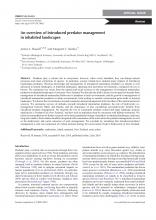A reassessment of factors, particularly Rattus rattus L., That influenced the decline of endemic birds in the Hawaiian Islands / I.A.E. Atkinson

BRB
Between 1892 and 1930, 58 percent (30 taxa) of Hawaiian endemic forest birds either were greatly reduced or became extinct. The order in which the islands experienced major declines ofseveral forest birds is Oahu (ca. 1873-1887), Hawaii (1892-1900), Mo10kai (1893-1907), Maui (18941901), Kauai (after 1900), and Lanai (1926-1932). Loss of habitat, reduced food supply, introduced avian diseases, as well as predation by man, feral cats, mongooses, and Norway rats (Rattus norvegicus) all appear to have reduced some species ofbirds, but none ofthese factors adequately explains the accelerated rates ofdecline offorest birds that occurred after 1892. Although it has been assumed that roofrats (Rattus rattus) reached Hawaii with the first European ships at the end of the 18th century, there is circumstantial evidence, independent of the bird decline data, that indicates that this rat did not arrive until after 1840, probably between 1870 and 1880. The hypothesis is advanced that after its establishment on Oahu in the 1870s, R. rattus spread to the remaining large islands in the group, resulting in a stepwise accelerated decline offorest birds on each island in turn. Hawaii thus parallels some other Pacific islands where major reductions of birds have followed the establishment of R. rattus. The need for precautions to prevent rats from reaching rat-free islands in the Hawaiian group is emphasized.
